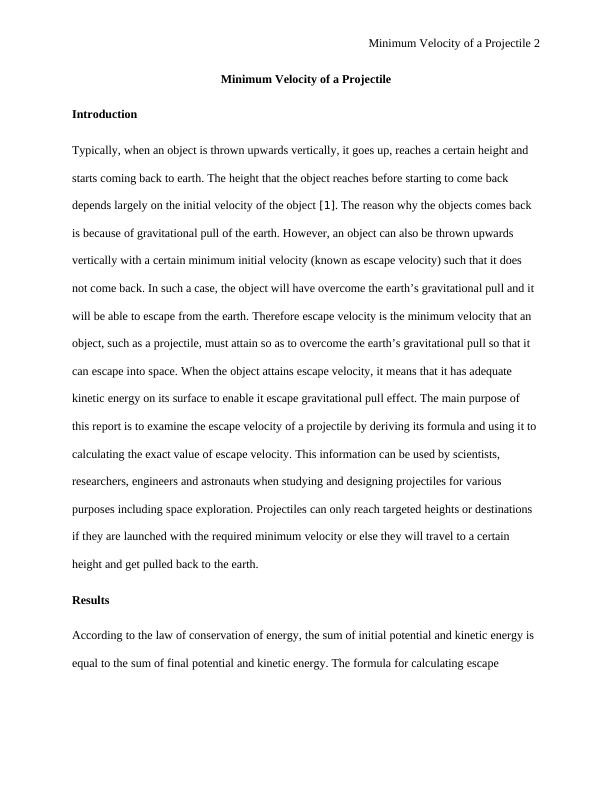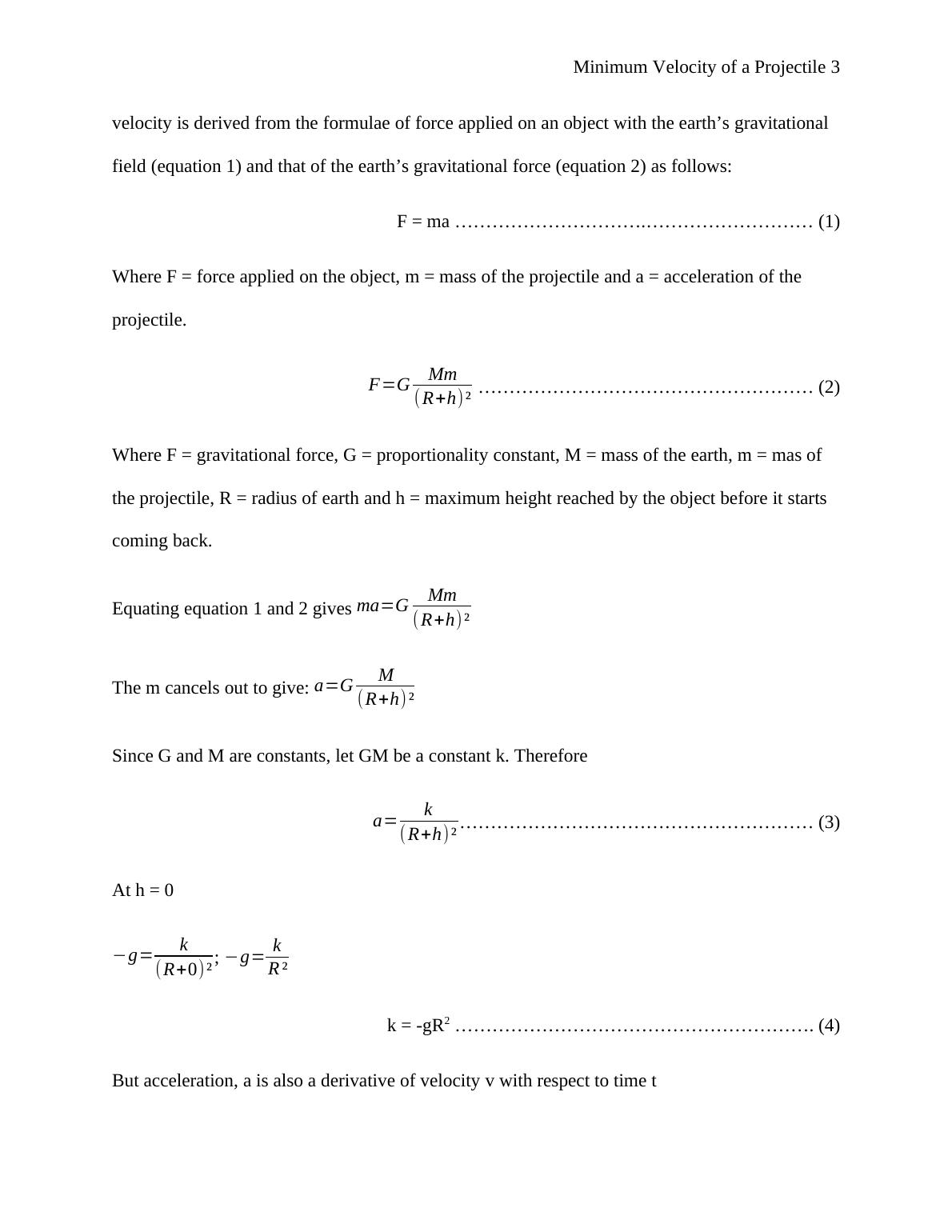Minimum Velocity of a Projectile
Added on 2022-12-27
7 Pages1483 Words4 Views
Minimum Velocity of a Projectile 1
MINIMUM VELOCITY OF A PROJECTILE
Name
Course
Professor
University
City/state
Date
MINIMUM VELOCITY OF A PROJECTILE
Name
Course
Professor
University
City/state
Date

Minimum Velocity of a Projectile 2
Minimum Velocity of a Projectile
Introduction
Typically, when an object is thrown upwards vertically, it goes up, reaches a certain height and
starts coming back to earth. The height that the object reaches before starting to come back
depends largely on the initial velocity of the object [1]. The reason why the objects comes back
is because of gravitational pull of the earth. However, an object can also be thrown upwards
vertically with a certain minimum initial velocity (known as escape velocity) such that it does
not come back. In such a case, the object will have overcome the earth’s gravitational pull and it
will be able to escape from the earth. Therefore escape velocity is the minimum velocity that an
object, such as a projectile, must attain so as to overcome the earth’s gravitational pull so that it
can escape into space. When the object attains escape velocity, it means that it has adequate
kinetic energy on its surface to enable it escape gravitational pull effect. The main purpose of
this report is to examine the escape velocity of a projectile by deriving its formula and using it to
calculating the exact value of escape velocity. This information can be used by scientists,
researchers, engineers and astronauts when studying and designing projectiles for various
purposes including space exploration. Projectiles can only reach targeted heights or destinations
if they are launched with the required minimum velocity or else they will travel to a certain
height and get pulled back to the earth.
Results
According to the law of conservation of energy, the sum of initial potential and kinetic energy is
equal to the sum of final potential and kinetic energy. The formula for calculating escape
Minimum Velocity of a Projectile
Introduction
Typically, when an object is thrown upwards vertically, it goes up, reaches a certain height and
starts coming back to earth. The height that the object reaches before starting to come back
depends largely on the initial velocity of the object [1]. The reason why the objects comes back
is because of gravitational pull of the earth. However, an object can also be thrown upwards
vertically with a certain minimum initial velocity (known as escape velocity) such that it does
not come back. In such a case, the object will have overcome the earth’s gravitational pull and it
will be able to escape from the earth. Therefore escape velocity is the minimum velocity that an
object, such as a projectile, must attain so as to overcome the earth’s gravitational pull so that it
can escape into space. When the object attains escape velocity, it means that it has adequate
kinetic energy on its surface to enable it escape gravitational pull effect. The main purpose of
this report is to examine the escape velocity of a projectile by deriving its formula and using it to
calculating the exact value of escape velocity. This information can be used by scientists,
researchers, engineers and astronauts when studying and designing projectiles for various
purposes including space exploration. Projectiles can only reach targeted heights or destinations
if they are launched with the required minimum velocity or else they will travel to a certain
height and get pulled back to the earth.
Results
According to the law of conservation of energy, the sum of initial potential and kinetic energy is
equal to the sum of final potential and kinetic energy. The formula for calculating escape

Minimum Velocity of a Projectile 3
velocity is derived from the formulae of force applied on an object with the earth’s gravitational
field (equation 1) and that of the earth’s gravitational force (equation 2) as follows:
F = ma .......................................................... (1)
Where F = force applied on the object, m = mass of the projectile and a = acceleration of the
projectile.
F=G Mm
( R+h) ² ...................................................... (2)
Where F = gravitational force, G = proportionality constant, M = mass of the earth, m = mas of
the projectile, R = radius of earth and h = maximum height reached by the object before it starts
coming back.
Equating equation 1 and 2 gives ma=G Mm
( R+h) ²
The m cancels out to give: a=G M
(R+h) ²
Since G and M are constants, let GM be a constant k. Therefore
a= k
(R+h) ² ......................................................... (3)
At h = 0
−g= k
(R+0)² ; −g= k
R ²
k = -gR2 .......................................................... (4)
But acceleration, a is also a derivative of velocity v with respect to time t
velocity is derived from the formulae of force applied on an object with the earth’s gravitational
field (equation 1) and that of the earth’s gravitational force (equation 2) as follows:
F = ma .......................................................... (1)
Where F = force applied on the object, m = mass of the projectile and a = acceleration of the
projectile.
F=G Mm
( R+h) ² ...................................................... (2)
Where F = gravitational force, G = proportionality constant, M = mass of the earth, m = mas of
the projectile, R = radius of earth and h = maximum height reached by the object before it starts
coming back.
Equating equation 1 and 2 gives ma=G Mm
( R+h) ²
The m cancels out to give: a=G M
(R+h) ²
Since G and M are constants, let GM be a constant k. Therefore
a= k
(R+h) ² ......................................................... (3)
At h = 0
−g= k
(R+0)² ; −g= k
R ²
k = -gR2 .......................................................... (4)
But acceleration, a is also a derivative of velocity v with respect to time t

End of preview
Want to access all the pages? Upload your documents or become a member.
Related Documents
Escape Velocitylg...
|6
|972
|407
Calculus Assignment: Displacement, Acceleration, Kinetic Energy, Charge and Volume Calculationslg...
|8
|1423
|187
Single Degree of Freedom Vibrationlg...
|16
|1187
|243
Conservation of Momentum Assignmentlg...
|22
|604
|52
